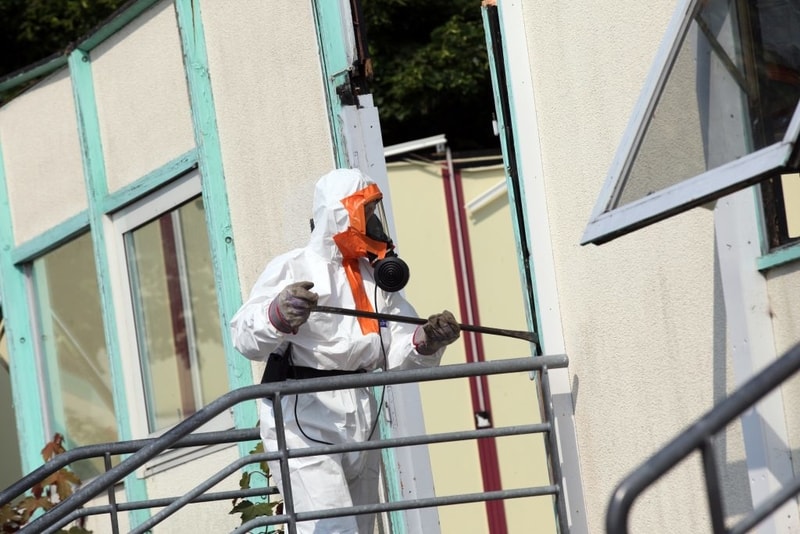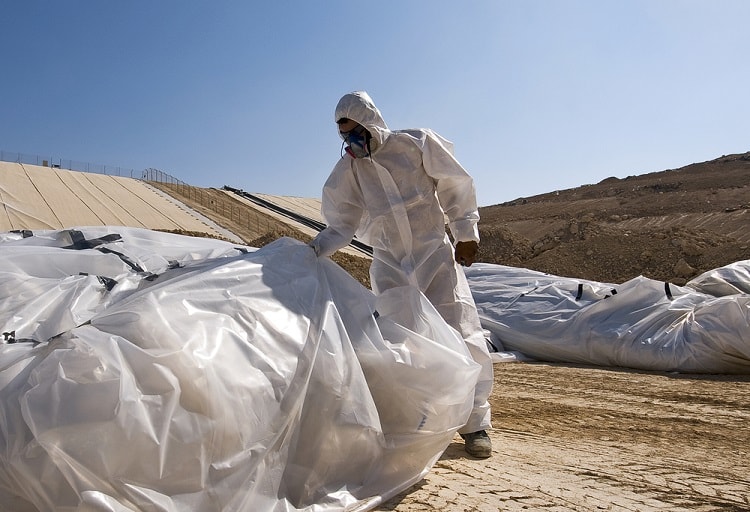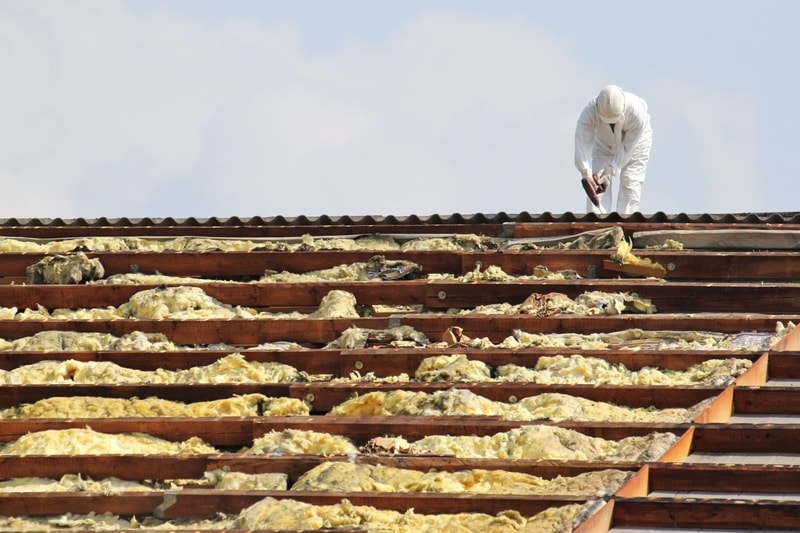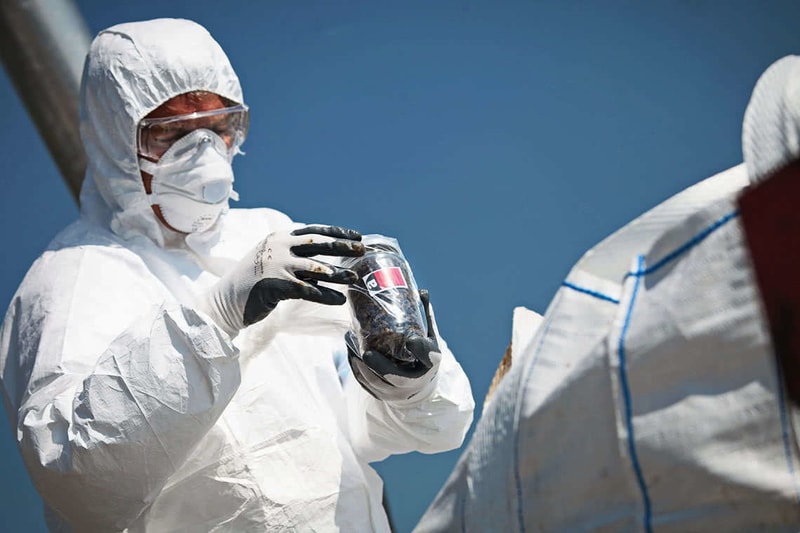Test
What is asbestos and why was it ever used in siding, given that it no longer is? We have created the most extensive, single article on asbestos siding to try and answer all the possible questions that you may have regarding the material, testing it, removing it, the associated cost and other questions we have been asked over the years with regards to this material.
Whatever your question is, trust me, you’re not the first person to ask about it.
Need to have asbestos siding removed? Simply use the form below and we’ll send your request out to the 4 most relevant contractors in your area to help with your asbestos removal project. It’s completely free for you! You can also scroll down to continue reading about asbestos.
What is Asbestos?
Before we proceed with this article, it’s a good idea to start out by first getting a better understanding of what exactly asbestos is. In fact, many older homes in the U.S. and Canada still contain the material, although its use was previously limited.
In fact, asbestos is a naturally occurring mineral that was added to Portland cement between the 1920s and 1980s. Portland cement is still used to this day in mixing with other materials to create fiber cement siding, that in turn is installed by fiber cement siding contractors.

The pressed asbestos and Portland cement shingles were available in a lot of different textures, profiles and sizes with many different advantages to this product, which was why it ended up being so widely used. We’ll talk about some of its advantages later on.
The silicacte mineral, asbestos, has been mined for more than 4,000 years. The addition of this mineral was done because it helped create fire-retardant materials that were strong and durable.
Pros and Cons of Asbestos and Its Use in Siding
Asbestos wasn’t put into the siding production process for nothing – it has a lot of pros, while also having a lot of cons which is why it was ultimately banned in a lot of countries. Read on to find out all the pros and cons of asbestos in siding.
Pros
- Its durability – when used with Portland cement, the planks and shingles that came out of it in the end were very durable, which undoubtedly is one of the things to look for when you’re having siding contractors help protect your home against the elements.
- Its ability to be painted – because paint adheres to it very effectively, it’s also a material that is really easy to paint on.
- Ease of cleaning – cleaning asbestos siding is really easy and it therefore makes it easier to maintain than wood siding, for instance. The only issue is making sure that it doesn’t get damaged in the process, which is what would start making things problematic.
- Low cost of maintenance – given that it is easy to maintain, the associated cost also becomes comparatively low, which just helps in making it more appealing.
- Fire-retardant properties – the addition of asbestos helped make the panels more fire-retardant, undoubtedly also something that is appealing.
- Good resistance to the elements
- Insulating properties – insulation is clearly something that helps you save electricity, and while it’s become more of a focus in recent years, it’s always been an advantage in any building material.
- Undisturbed asbestos poses no risk – that’s right, if not damaged, simply protecting your home against the elements, asbestos doesn’t cause problems.
- Cheap – North American mines could provide the material that added all these pros to the material, and even at a low cost.
Cons
With the pros being mentioned about asbestos siding, it’s also important to mention the cons, since there’s a reason why the material was banned in many countries.
- It can cause cancer if airborne – if the fibers become airborne, inhalation of the fibers can cause cancer. Read more about it in the sections below.
- Cutting it will cause airborne fibers to go up in the air
- Dealing with the material should be done by a pro to make sure it’s done correctly – there’s a reason why the image below is not an unfamiliar site when it comes to contractors dealing with asbestos. They don’t want to inhale the fibers either.

Is Asbestos Siding Safe? How Dangerous is it Right Now? Health Concerns Related to the Material
While it’s technically been included in the pros and cons, we hope that this individual section on the topic might catch the eyes of those people that possibly only skim through the article.
So is asbestos siding safe, and what makes it dangerous? What are some health concerns you need to be aware of related to the material?
It took decades to confirm that inhaling asbestos fibers were helping cause cancer, more specifically mesothelioma and asbestosis.
When that’s been said, you shouldn’t start worrying immediately if you don’t exactly know what type of siding material is installed on your home. Asbestos is safe as long as it’s not airborne and you don’t inhale it.
The problems arise with the siding contractors that were exposed to it, and cutting it over long periods of time, which have over time led to a lot of case of mesothelioma. They’ve over time been exposed to high levels of airborne fibers that have made it into their lungs.
However, despite all of this a lot of homeowners are still opting to have it removed from their home. You don’t want to potentially be inhaling the fibers if they become airborne due to breakage.
How to Remove Asbestos Siding

For removal of asbestos siding, we strongly urge you to use our website to get free quotes for the project. Unnecessarily exposing your health to the dangers of improperly removing it is simply not worth the risk.
Siding that is being removed can become friable, meaning it can be damaged by hand pressure, at which point you could be exposing yourself to those damaging fibers. Heat, water, weathering or simple aging also makes the material more fragile, at which point it can become dangerous to work with.
The general steps included in removing asbestos siding are:
- Using sheeting around the house in order to make sure debris falls onto it and can easily be removed.
- Make sure the area is clear and that people are kept away from it. This includes posting warning signs.
- Steps should be taken to keep any material from being dragged into the house.
- Wear sufficient protective gear to stay protected. This includes a respirator with P100 cartridge filters to keep you protected from the airborne particles. The respirator you use needs to be approved for the specific use. While you may think dust masks are good enough, they’re not. It’s not all people that are medically able to wear them so you should be sure that no conditions are keeping you from being able to wear one. Consult your doctor to be safe.
- Be sure that the equipment is worn according to the instructions of the manufacturer.
- Get disposable coveralls and wear them so that you don’t have to throw your own clothing away afterwards. If they don’t cover the boots, you will want to wear shoes that can be thrown away afterwards.

- The coveralls should cover as much of hte body as possible.
- Make sure windows and doors are kept closed during the process to keep particles from entering the house.
- The material was installed from the bottom up, so the removal should start from the top and work its way down to make the process as smooth as possible.
- During the removal, the material will need to be kept wet as this will limit the amount of airborne particles. Wetting the material is an ongoing process to make sure it stays wet. Until it is out into the disposal containers, the material should stay wet.
- Keep breakage to an absolute minimum as that is when a lot of the fibers become airborne too. That is no matter if it’s roofing or siding that you’re working with.
- Avoid dropping or throwing the material as it will cause breakage, instead lower it gently.
- The material that has been removed needs to be put into bags that won’t leak or sheeting that contaminates any airborne fibers. The bags should be heavy duty.
- Tools should be washed after the process has been finished too.
- You should ideally not have had any exposed skin during the process, but washing yourself thoroughly is a safer practice to get rid of any remains.
- Throw away anything that you were wearing in the process, which is where the disposable coveralls come in handy.
- Disposing of the material afterwards is the last step. Not all waste haulers will accept asbestos waste, and this could mean you have to find an approved landfill that will accept it for you so that it isn’t dangerous to others.
If done improperly, it’s a process that could get the particles inside the house, which you’ll want to avoid and it’s recommended to have it done professionally when you do wish to have it removed.
How Much Does Asbestos Siding Removal and Abatement Cost?

Besides being safer, you might find out that it is in fact a better financial decision to have a pro come and do it for you since you’ll otherwise be needing a range of different tools and material to get it done.
When you want the most accurate cost per square foot for asbestos siding removal, your best option is to contact competing contractors and get them to bid on the project – that’s a project we’ve made very easy for you through our website. Asbestos siding removal isn’t free, but if you’re having it replaced with something else, you just might be able to get a good deal with the company you end up choosing.
The reported costs for such projects range from $500 to $4,500, while the typical cost for asbestos siding removal is generally between $1,000 and $2,500. The average lies in between those two numbers.
The cost you end up paying will depend on a couple of different factors including if there’s damage to the area that’s being worked on and how big the size of the area is.
Material and Equipment Costs Related to Removing it
There’s a lot of special equipment and materials that will be needed to do asbestos removal safely, which is also why it often doesn’t make sense for you to start going out to buy the different things to do the project yourself.
Here’s a quick breakdown of the different equipment that is needed and what it will often cost you if you choose to get it yourself:
- HEPA Vacuum – More than $800
- Disposable Gloves – $5-10
- Rubber boots – $25-30 per pair
- Disposable coveralls – $25
- Protective eyewear – $20 per pair
- Respirators – $100
- HEPA filtration units
While you may be able to find some of the things cheaper, remember that they’re used to help you stay protected and that you don’t always want to have the cheaper option when it comes to staying safe. The materials mentioned above are just some of the different things that you will need for the project.
What is the HEPA Vacuum For and is it Really Necessary?
The area needs to be cleaned after the removal has taken place, and that needs to eb done using a HEPA vacuum, which stands for a High Efficiency Particulate Air vacuum. There are very strict regulations that require these to be especially efficient, therefore able to remove asbestos fibers also.
The dust that is left behind needs to be safely removed, hence the need for an expensive vacuum, and why your everyday one just isn’t good enough.
Particles may also have made it inside the house despite the best efforts, and it’s therefore recommended to have the house cleaned using this vacuum, although the project took place outside to be sure. HEPA vacuums are also not made equal, some of them being better for such a project than others. You need the ones that have the required industrial capabilities needed for such a project.
Since there are different fiber sizes when it comes to asbestos, some of them can pass by vacuums if they aren’t industrial strength.
A pro has access to the needed equipment.
Can I Remove Asbestos Siding Myself?
Whether or not you can remove asbestos siding yourself comes down to a couple of things? Do you really want to go out and acquire all the different things going into the process to have it done, and also ensure that it is done safely, as well as putting in the hours it will take to actually do it and dispose of it?
The above sections clearly illustrate some of the difficulties in actually doing the job – it’s not easy, especially not if you don’t have the proper training.
Is it Illegal to Remove Asbestos Yourself?
Whether or not removing asbestos yourself is illegal or not depends on the state that you’re living in. Most states don’t have licensing requirements when the work is being done by the homeowner, although a contractor handling it should obtain the necessary licenses. California requires contractors to have the C22 license classification to be able to remove asbestos.
Hiring licensed contractors to do the work is how you know you get it done safely.
While there may not be many federal requirements regulating the specific area, the EPA still encourages that the work is done by a pro. If you’re considering doing the work yourself, you will want to make sure to look into local regulations to make sure you’re in fact allowed to do it since local regulations may be preventing you from doing it.
There could also be different licenses that are required before work may be started in an area containing asbestos. The situation across states is therefore not easy to say something about and our best advice is that you seriously consider looking into local regulations, especially if you want to do the work yourself.
Permits are generally required when it comes to demolition, and it is generally only legal for homeowners to remove asbestos on single-family units.
How to Dispose of Asbestos Siding?
Disposing of asbestos siding is not as easy as disposing other building materials, which is why we’ve often been asked the question of what the process includes.
The health implications related to working with the material means that you can’t just simply throw it away where you might prefer. It can’t be dumped in the trash or on the curb unlike general waste.
The disposal of it will vary between states, which you’ll need to research yourself if you’re the one doing the project, otherwise a pro will know and can guide you.
It’s often considered hazardous waste, even if there’s only a very small amount of asbestos in the materials, whether it’s siding or something else. It often only takes 1% asbestos in the materials for it to be considered hazardous waste. While this article talks about the implications related to siding, it can also be found in other types of materials in your home, meaning you might not just be able to dispose of those construction materials either as you desire, and this creates certain challenges when you’re remodeling your home.
There’s also often a cost to dispose of asbestos siding since it is so heavily regulated.
That’s also why you in fact need to test to see if there is in fact asbestos in the building materials.
Other Places That Can Have Asbestos In Them
It’s not just siding that was made, a bunch of other materials also had asbestos added to them in the construction process. Here’s a list of some of them.
- Asbestos insulation in the form of loose-fill insulation (the type being the one containing vermiculite).
- Asbestos ceiling tiles
- Asbestos floor tiles
- Asbestos pipe insulation
- Popcorn ceiling containing asbestos
- Tile adhesive, backing
- Heat-resistant materials around stoves
- Textured paint
Asbestos Siding Removal Grants
Finding and applying for grants to help you get the asbestos removed can be complicated, and if your desire is to save money on the process, your best bet is to make sure to get quotes from different asbestos abatement companies to make sure you don’t end up overpaying for the project. Since different states often have different grant programs, it’s also difficult to write anything general about it here.
The process of getting a grant for it won’t be easy, however, even if you find one that you qualify for. You’ll need to research at state level to see if there are any assistance programs you may eb able to get help from.
What Does Asbestos Siding Look Like and How to Identify it?
It can be hard to just visually be able to identify if a material contains asbestos or not since there’s not a specific thing that it looks like. However, there are some different things you can be looking for to figure out if it contains it or not, at least when it comes to shingles. Other products may be harder.
Generally it requires either a lab test or inspection by a pro to determine if asbestos is present or not.
- When was it installed – fiber cement siding that was installed before the material was limited in its use will likely have it included in them, simply because it came with so many different benefits.
- Code stamping – on the back of new shingles, a code is often stamped to indicate what it contains.
- Are there several layers of siding wall cladding extending out past the original door trim or window trim could be an indication of several layers of siding – the one behind is likely containing asbestos since it was such a popular material previously.
Can You Buy or Sell a House With Asbestos Siding on it?
If you take the time to look around the internet researching the topic, you’re likely to see that both buyers and sellers are worried whether it will cause problems for them to either sell a house that has asbestos siding on it or buying a house which has it.
Can you sell a house with asbestos siding? It will likely be harder given that homeowners would prefer materials that they do not believe pose health risks to them.
Should you buy a house with asbestos siding on it? Well, if it’s in good condition, you shouldn’t worry about it. The question is whether that’s the case or not. Before buying any house, it’s important that you get a thorough home inspection of it to determine any possible issues it could have, and this will also reveal the condition of the siding.
When Did it Get Banned and Stopped Being Used?
The fact is that the material hasn’t been banned in the United States. It has been banned in a lot of other countries, but its use has been banned in products that don’t historically contain asbestos and has been seriously limited. However, banned it is not. It can therefore be a good idea to find out if the construction contractors you are planning to use for your various building needs intend on using products that do or don’t contain it. The easiest way is simply to ask them about it.
Testing for Asbestos With a Testing Kit

The easiest way to figure out if your given building products contain asbestos or not is to have a lab test done. You can simply head over to Amazon and find a test and it will have instructions on how to use it and which lab will be testing what you’re sending them. Such lab tests typically cost around $30.